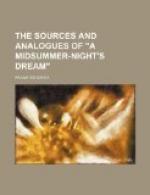From these instances a literary origin for Bottom’s transformation seems probable but Shakespeare may himself have fallen in with a survival of the witch-superstition Almost while writing these words I receive first-hand evidence that such a tradition is not yet extinct in Welford-on-Avon, a village, four miles from Stratford, with which Shakespeare must have been perfectly familiar. The witch, as usual, was an old woman, credited with the “evil eye” and the power of causing the death of cattle and farm-stock by “overlooking” them; and the native of Welford, from whom the story was communicated to me, would be prepared to produce eye-witnesses of various transformations of the old woman into some kind of animal—transformations effected not only at Welford, but even in the centre of Stratford on market-day!
Shakespeare had probably met with the story of Pyramus and Thisbe in more than one form. Golding’s translation in 1575 of the story in Ovid’s Metamorphoses[24] is reprinted in this book[25]; Chaucer included the Legend of Thisbe of Babylon as the second story in the Legend of Good Women; and there appears to have been also “a boke intituled Perymus and Thesbye,” for which the Stationers’ Register record the granting of a license in 1562. There is, too, a poem on the subject by I. Thomson in Robinson’s Handeful of Pleasant Delites (1584).
The Historia de Piramo e Tisbe was very early in print in Italy, and continued to be popular in chap-book form until the nineteenth century at least.
In his commentary on A Midsummer-Night’s Dream in the larger Temple Shakespeare, Professor Gollancz points out the existence of a Pyramus and Thisbe play, discovered by him in a manuscript at the British Museum.[26] This MS. is a Cambridge commonplace book of about 1630, containing poems attributed to Ben Jonson, Sir Walter Raleigh and others, though the greater portion of the contents appear to be topical verses and epigrams unsigned. Amongst these is “Tragaedia miserrima Pyrami & Thisbes fata enuncians. Historia ex Publio Ovidio deprompta. Authore N.R.” In the margins are written corresponding passages in Latin from Ovid, whose story it follows closely.
The play is in blank verse of a poor kind with occasional rhyming couplets. After a prologue begins “Actus Primus and ultimus”; there are only five scenes in all, and the whole is quite short. The characters consist of Iphidius, father of Pyramus; Labetrus, father of Thisbe; their children, the protagonists; their respective servants, Straton and Clitipho; and Casina, “ancilla” or handmaid to Thisbe. There is also “a raging liones from ye woods.” The moral of the play, as stated by Iphidius, is that
“the erraticall motions in children’s
actions
Must to a regular form by parents be reduc’d.”
These lines, and others in the play, would gain by being “reduc’d to a regular form.”




